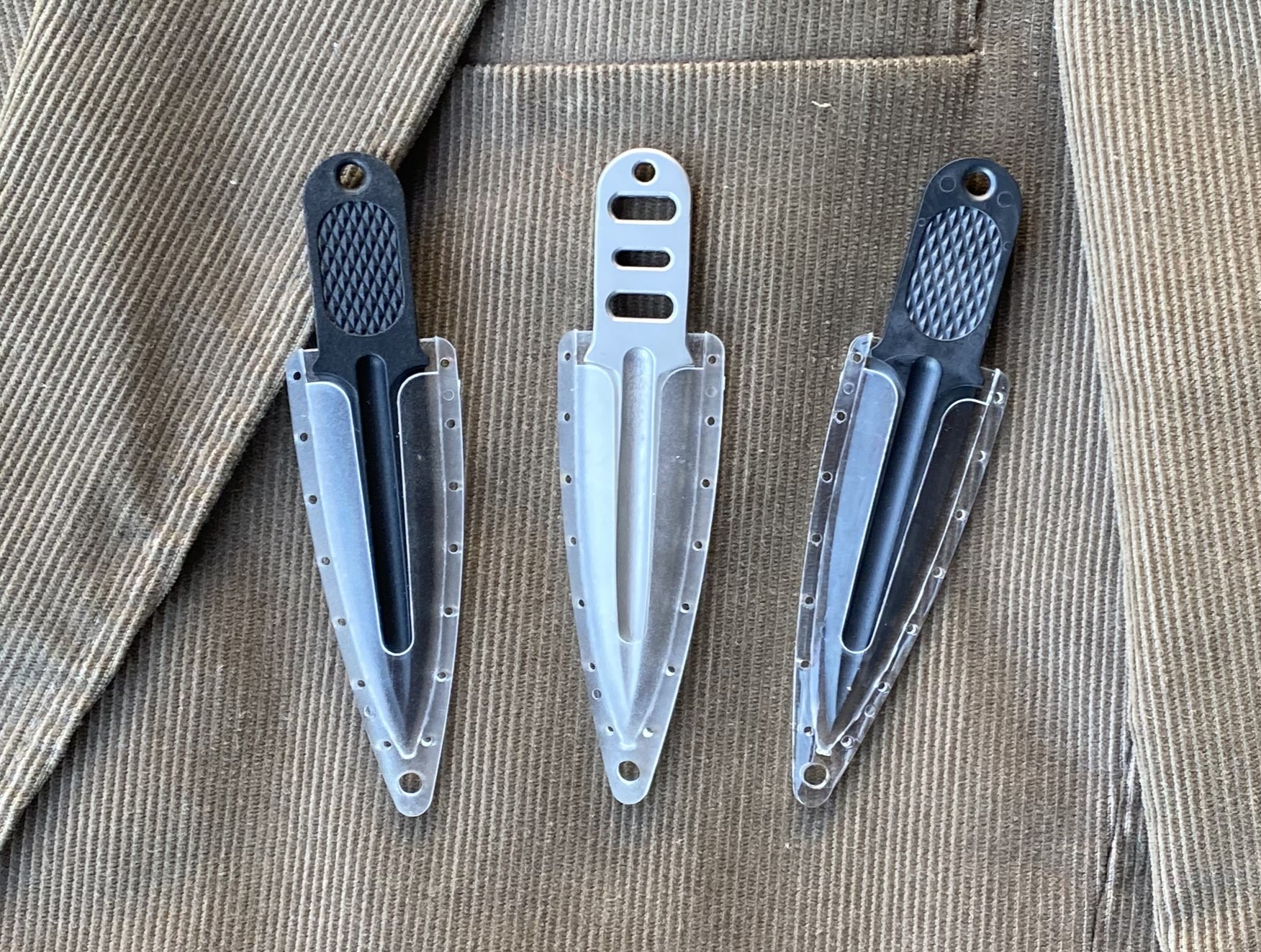Hardcase Survival Lapel Dagger is designed as a last ditch weapon like the original SOE/OSS lapel or thumb dagger.
Hard Case Survival was founded in 2004 The founder was a SERE (Survival, Evasion, Resistance and Escape) specialist in the U.S. Air Force. He is also the owner of Southern Specialties, manufacturer of high-quality lock picking tools. His goal in establishing Hard Case Survival was to offer products related to SERE and survival, with a focus on E&E (escape and evasion) gear. Hard Case Survival also currently offers 1–4-day training classes in surreptitious entry and restraint escape for LEO, government and military customers only.
The Hard Case Survival Lapel Dagger is a modern upgraded version of the British Special Operations Executive (SOE) lapel or thumb dagger, which was issued to agents of the SOE and the U.S. Office of Strategic Services (OSS) during World War II. It is certain to be popular with aficionados of classic covert weaponry.
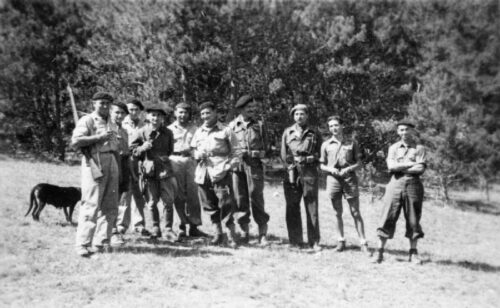
SOE was a top-secret British organization created in 1940 following the fall of France. Prime Minister Winston Churchill tasked Hugh Dalton, the Minister of Economic Warfare, with forming SOE. Three existing secret and operating departments of other ministries merged to conduct sabotage, espionage and reconnaissance in Nazi-occupied France, and to aid local resistance movements. Churchill’s instructions to Dalton were to “set Europe ablaze.” Colonel (later Major General) Sir Colin McVean Gubbins, KCMG, DSO, MC, was the prime mover on the SOE and its director from August 1943 onward. He had acquired considerable experience and expertise in guerrilla warfare as a regular Army officer.
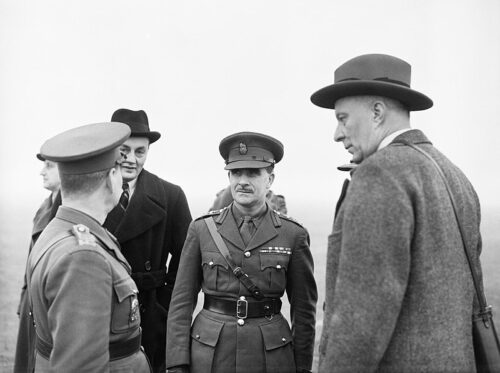
The OSS was established by President Roosevelt in June 1942 with Colonel (later Major General) William J. Donovan as its head. The OSS was tasked to collect and analyze strategic information required by the Joint Chiefs of Staff and to conduct special operations not assigned to other agencies. Wartime activities included the collection of intelligence, sabotage, propaganda, assisting anti-Nazi resistance movements in Europe, and providing military training for anti-Japanese guerrilla movements in Asia.
In September 1945, following victory over Japan, President Truman signed Executive Order 9621, which abolished the OSS and split its functions between the Department of State and the Department of War. The OSS was a predecessor of the Central Intelligence Agency (CIA). In Britain, the SOE was officially disbanded in January 1946. Many duties of the SOE have been taken over by the British Secret Intelligence Service (SIS), better known as MI6.
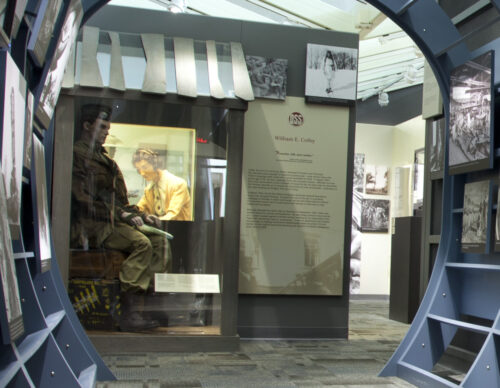
Numerous edged weapons were manufactured specifically for the SOE and OSS during World War II. Lapel/thumb daggers were issued to agents operating behind enemy lines as part of their escape and evasion kit. They were designed as covert weapons that could be secreted and stitched behind the jacket lapels or anywhere about the clothing for maximum concealability and ease of access. The small dagger blade was quick to bring into action and effective for striking strategic anatomical targets at close range. They were designed to be a weapon of last resort, allowing the agent to break contact and create distance or flee. They could also be used to cut through different types of bindings. Simply put, they were escape tools.
According to Lt. Colonel Leslie J. Cardew Wood, who was the Commanding Officer of Station XII, Aston House, a top-secret Research and Development Centre that developed explosives and weapons for the SOE. the lapel/thumb dagger was designed by the legendary William E. Fairbairn and fellow close-combat instructor Eric Sykes, who also designed the famous Fairbairn-Sykes Fighting Knife. The original thumb daggers were manufactured by H.G. Long & Co in Sheffield, and the sheaths were made by local Aston cobbler Arthur Acres. Over the course of the war, many different types of lapel/thumb daggers were used. Some were double edged. Others were single edged.
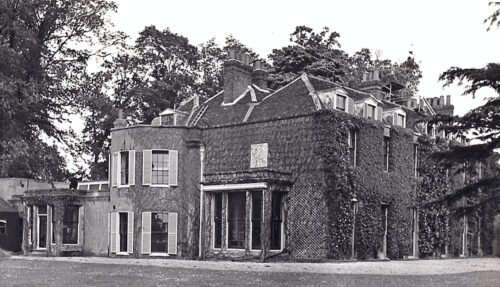
Although true to its World War II and subsequent Cold War era heritage, the Hard Case Survival Lapel Dagger brings a number of modern improvements to the original design. The Hard Case Survival Lapel Dagger is available in cast matte-finished stainless-steel, black glass-filled nylon (GFN) polymer, and black ceramic versions. Each has its pros and cons:
The stainless-steel dagger is tough and very durable. It may be easily resharpened. It has a high corrosion resistance. It obviously has a metallic signature and can be detected by common eddy-current metal detectors.
The GFN dagger is tough and non-corrosive but does not hold an edge. It is only useful for thrusting. It has a non-metallic signature and cannot be detected by common eddy-current metal detectors.
The ceramic dagger is very hard and non-corrosive. It stays sharp much longer than conventional steel blades, but it is brittle. Drop the ceramic on a hard surface and it may chip or break. It is tricky to sharpen but that is not an issue given the expected use of this type of knife. It has a non-metallic signature and cannot be detected by common eddy-current metal detectors.
The Hard Case Survival Lapel Dagger is sterile (no identifying markings).
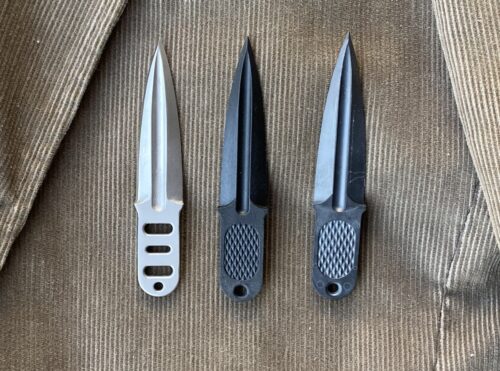
The Hard Case Survival Lapel Dagger has a chisel grind, i.e. beveled on one side only creating a chisel-like shape in cross section. It comes with one sharpened edge. It has a 2.5″ blade and overall length of 3.75″. The blade has a rounded fuller (a lightening groove often erroneously referred to as a “blood groove”), which is mostly for looks in this case.
Each dagger comes with a friction fit GFN sheath that holds the dagger very securely. The sheath has 14 holes to allow it to be sewn onto the lapel of a jacket or other location, just like the original SOE/ OSS lapel daggers were. It can also be concealed in other locations, such as pocket, waistband, sock, shoe or boot. The back of the sheath is flat, providing the option of attaching an adhesive-backed Velcro® fastener. There is also a hole on the bottom of the sheath for attachment of a cord for static line carry. Total overall length with the sheath is 4.25″ long.
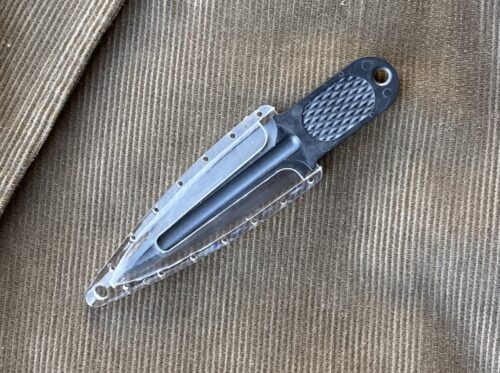
The stainless-steel version of the Hard Case Survival Lapel Dagger features a skeletonized handle that aids in grip retention and enables wrapping the handle with cordage to give the user a more secure grip. It can also be lashed to a stick to create a spear for survival situations. The GFN and ceramic versions feature a diamond texture for grip retention. All versions provide a surprisingly secure grip, especially considering the abbreviated grip.
Kevlar® survival cord is a popular choice for wrapping the handle on the stainless-steel version. Although it is a very thin cord that is similar in thickness to a thick thread, it has an astonishing 200 lb tensile strength. You can use it for many things, such as lashing, making snares, traps, bows or even sawing through cordage, tape or plastic flex ties.
All versions of the Hard Case Survival Lapel Dagger are equipped with a lanyard loop. The primary technique taught to SOE and OSS agents was to surreptitiously access the blade, wrap the lanyard loop cord around the index finger, and grip the weapon between thumb and index finger or between the index finger and middle finger.
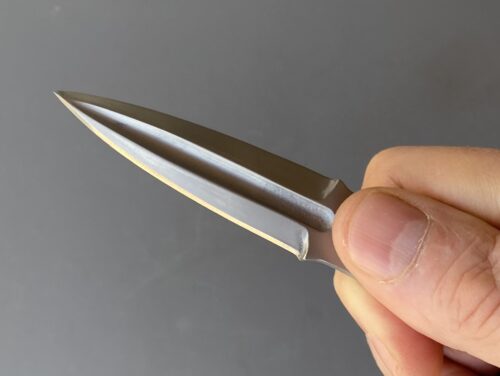
Well-concealed escape tools are often missed during initial searches by captors, and the captors will likely initially have less complicated and less secure restraints. These tools are an insurance policy when traveling in high-risk areas. Most small tools can be concealed by taping them to various places on the body, clothing, or footwear.
Layering helps ensure that if one tool is lost, discovered, or cannot be easily accessed, another tool will be available and accessible for use. It is essential to practice and become proficient with escape tools and techniques before you need them.
The Hard Case Survival Lapel Dagger is well-designed and well-made. It is also very inexpensive. The price on the Lapel Dagger ranges from $12 to $42 USD, glass-filled being the cheapest and ceramic the highest price. Check your local laws on ownership and carry.
Sources
Hard Case Survival
HardCaseSurvival.com
Southern Specialties
LockPickTools.com
Material Disclosure
I received this product as a courtesy from the manufacturer so I could test it and give my honest feedback. I am not bound by any written, verbal or implied contract to give this product a good review. All opinions are my own and are based off my personal experience with the product.
*The views and opinions expressed on this website are solely those of the original authors and contributors. These views and opinions do not necessarily represent those of Spotter Up Magazine, the administrative staff, and/or any/all contributors to this site.
